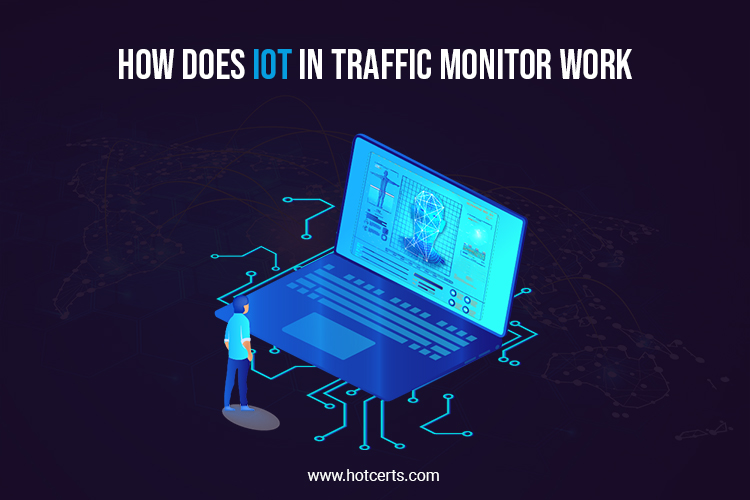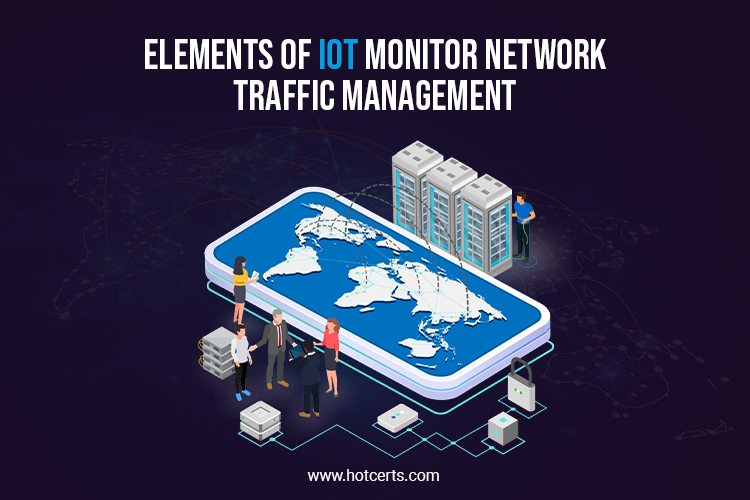The growing amount of traffic congestion and car accidents has become an issue. It has been proved that addressing these difficulties can be accomplished by collaborating on IoT Monitor Traffic development. The Internet of Things has the potential to improve traffic flow on roads while keeping people safe through activity monitoring devices, data analysis, and real-time communication.
In this day and age, traditional strategies for managing public transportation are increasingly ineffective. And there is an increasing demand for an effective traffic management strategy. Cities of all sizes desperately need technology-driven digital solutions to control and monitor transportation. They can aid in regulating heavy traffic, road obstructions at signals, and crowded networks.
Using technology such as wireless connectivity and intelligent sensors, an Internet of Things (IoT)-enabled adaptive traffic administration system can handle significant challenges. They are a cornerstone of an intelligent municipality, helping to improve the well-being and security of drivers, passengers, and pedestrians.
This blog will look at the role of the Best IoT Network Traffic management, the difficulties it can answer, and the technology required to build a smart system.
How is IoT Used to Monitor Traffic?
This innovative system comprises sensors, tags with RFID chips, and BLE signals strategically positioned at traffic lights for tracking vehicle flow. Real-time statistical analysis solutions allow control rooms to link to a map and a geographical information system (GIS), allowing real-time IoT monitor traffic management.
The intelligent traffic management system takes photos of automobiles at traffic lights using a technique known as “image interpretation.” This information is then relayed to the control center via devices.
BLE transmitters or RFID tags monitor vehicle movements, reducing traffic congestion. RFID scanners can aid in the recovery of stolen vehicles and the planning of emergency vehicle routes.
How Does IoT in Traffic Monitor Work?

For every application, the IoT Monitor Traffic Network requires the integration of various objects into a single centralized panel. Built-in sensors, for example, make it easier to gather and transfer data to the control panel.
IoT sensors are fitted in various cars for smart traffic control. These sensors work in conjunction with roadway signals, street lighting, and other devices. Sensors enable constant monitoring and aid in the reduction of accidents. Furthermore, IoT technology improves service quality and efficiency by allowing traffic control personnel to analyze data instantaneously collected by sensors.
IoT Monitor Traffic technology increases transportation safety. This is because data such as the number of automobiles at a traffic junction or crossing can be recorded and tracked, and necessary action is taken to avert accidents or disasters.
Based on data gathered by sensors, traffic control specialists can optimize design processes to reduce operating expenses. IoT sensors may additionally track changes in travel patterns and offer drivers real-time data, allowing them to pick routes that minimize traffic jams.
The best IoT Network Traffic technology enables connected automobiles. In other words, automobiles can be linked to IoT, making it possible to detect the car from a distance. It also aids in monitoring driver behavior, driving style, and so on. IoT sensors also provide information about the sort of vehicle, its intended location, speed, and other factors. All of this information aids in traffic management and downtime reduction.
Internet of Things (IoT) technology not only decreases traffic jams and road accidents but also reduces auto gasoline consumption, which benefits the environment.
An intelligent IoT monitor traffic control system provides real-time data-driven traffic signal management. IoT sensors capture data on the total number of vehicles on the road, traffic congestion, the climate, and other factors.
Benefits of Using IoT in Traffic Monitoring
Consuming IoT in traffic control monitoring aids in educating traffic flow, quickly recognizing difficulties, and upholding driver safety. This improves transport system efficiency and upsurges overall driver well-being on the roadways.
-
Improved Traffic Flow
We can now, with the assistance of the IoT. Examine real-time traffic information. These allow governments to monitor traffic tendencies and identify overfilled locations.
On the other hand, this data can be used to expand traffic signal coordinated events, enable suppleness in lane management, and deliver solutions for traveling over congested locations.
The Internet of Things examines IoT, monitors traffic and recovers traffic flow by making data-driven choices, reducing journey times, and growing overall passenger efficiency.
-
Safer Transportation
Autonomous driving safety, thanks to IoT Monitor Traffic technology, is no longer science fiction. Every day, it makes our roads safer. Advanced early warning systems advise drivers of potentially hazardous circumstances ahead, allowing them to modify their velocity or route before entering risky zones.
Moving on to another outstanding benefit: encouraging a cleaner environment. Smoother traffic flow minimizes car emissions. With a smart device handling the city’s traffic problem, we’re getting wherever we need to go faster and safer and leaving a more negligible carbon impact.
-
A Greener Planet
We could fail to be able to quit driving entirely, but even modest improvements like this make a difference. According to the EPA, traffic accounts for roughly 29% of the release of greenhouse gases in the United States; imagine what a difference more effective traffic control could make.
-
Event Detection in Real Time
IoT network traffic monitoring devices like sensors and cameras can detect events, vehicle breakdowns, and possible road hazards in real-time.
This vital information is instantly transferred to the IoT in managing the traffic control center, allowing for response and the appropriate actions to rectify the difficulties.
The installation of IoT helps to ensure traffic flow by quickly alerting persons to concerns so that they may solve them effectively.
-
Additional Safety Measures
Traffic monitoring, made possible by the Internet of Things (IoT), improves road safety. It is now practicable to recognize vehicles that exceed speed limits, shift road lanes, or disturb lights by using traffic cameras and sensors.
Drivers may earn opportune warnings about possible safety issues. Furthermore, IoT Monitor Traffic devices let the delivery of real-time weather and highway status reports. This allows both drivers and controllers to adopt practical safety safety measures.
How is IoT Transforming Traditional Traffic Monitoring Systems?

The utilization of IoT Monitor traffic technology has meaningfully wedged traffic regulation, transporting smart solutions that recover road security and competence. The world of commutation is rapidly altering, from adaptive traffic signs or signals to rescue facilities via IoT.
- Intelligent Traffic Signals: Modern traffic signals are becoming more ground-breaking due to IoT-powered tactics. They may modify or change their real-time series according to road circumstances, resulting in flatter trips and condensed congestion.
- IoT Technology for Emergency Assistance: Every second staples throughout an emergency. When an coincidence occurs, IoT monitor traffic devices in autos and wayside infrastructure deliver rapid connectivity, permitting emergency facilities to respond faster.
- Using IoT Technology, You Can Park Vigorously: No more driving from place to place in circles stalking for a parking spot. Smart parking systems use combined sensors in parking homes to provide drivers with real-time info on accessible locations, saving period and decreasing extravagant emissions produced by automobiles wasting while looking for open slots.
- Safety First: Improving Truck Driving and Fleet Management – IoT applications expand into driving trucks as well; fleet managers gain vital information about vehicle health, which aids in preventing failures. They also obtain information about driving habits, which helps to enforce safe driving practices.
Vehicle Predictive Maintenance: Owners who put IoT Monitor Traffic devices in their vehicles receive alerts about forthcoming repair requirements based on automobile usage patterns, a boon for guaranteeing the durability and security of their rides.
Key Elements of IoT Monitor Network Traffic Management

An intelligent IoT monitor traffic network management system functions as the town’s infrastructure’s brain, ensuring everything operates smoothly. So, what differentiates this brain? Let us now look at its main components.
-
Data Analysis in Real Time
Real-time data analysis is the driving force behind any adaptive traffic system. Cities have integrated sensors and vehicle cameras connected to monitor driving motion and mobbing levels. This data is fed into multifaceted algorithms that can forecast visitor behavior and change signal timings to diminish delays.
-
Intelligent Traffic Signals
Unlike unvarying traffic signals, smart traffic lights do not work on programmed timers. Instead, they regulate to real-time traffic conditions, such as adapting light patterns when roads keep on clear or prolonging green periods during demanding hours, thereby plummeting travel time.
-
Internet of Things-Assisted Emergency Response
In situations where each instant counts, IoT in traffic monitor technology comes in nearby by quickly clearing paths for emergency vehicles via ordered signaling at crossings, radically lowering response times.
-
Monitoring of Road Conditions
Another critical constituent of a successful smart organization system is roadway conditions nursing; integrating sensors placed in the roadway that offer crucial data concerning deterioration or weather-related hazards such as ice expansion during winters help in keeping our travels safer.
-
Vehicle Automatic Maintenance and Fleet Management
Vehicles with integrated IoT devices offer predictive upkeep by continuously tracking presentation, preventing unanticipated breakdowns. For fleet direction, IoT enables incessant vehicle position and position monitoring, resulting in more actual route preparation and lower fuel use.
-
Tolling and Ticketing System
The intelligent toll-collecting organization eliminates monetary transactions at toll booths consuming RFID tags or mechanically identifying license plate devices. At the same time, the ticketing system is efficient through mobile apps for informal parking settlements and fines.
FAQs (Frequently Asked Questions)
What is IoT Monitor Traffic?
Using technology such as wireless connectivity and sophisticated sensors, an Internet of Things (IoT)-enabled smart traffic administration system can handle significant challenges. They are the groundwork of an intelligent city, helping to recover the well-being and safety of drivers, travelers, and inhabitants.
How IoT is Utilized in Traffic Monitoring?
IoT sensors capture data on the total number of vehicles on the road, traffic jams, conditions of weather, and other factors. This vital information is then examined and presented on a regional control panel. Traffic supervisions and administrations can monitor traffic circumstances on the energetic control panel.
Which IoT Sensor is Used in Traffic Monitoring?
Doppler IoT sensors are employed in improved Traffic Monitoring. These sensors make use of the ultrasonic Doppler effect. They detect vehicles wandering in a specific way by changing bandwidth (the Doppler impact) in reply to the vehicle’s speed.
Conclusion
The Internet of Things (IoT) has an impact on traffic monitoring. These mechanisms provide immediate knowledge of traffic trends by combining sensors, gadgets, and data processing. Furthermore, this allows for better resource allocation and urban planning. The concept of employing IoT monitor traffic addresses the relationship between connection and traffic control. These precautions do not improve safety.
Reduce congestion while also promoting long-term city expansion. Furthermore, as technology advances, exploiting an opportunity for IoT in traffic monitoring could make cities worldwide more intelligent and livable. This fusion of creativity and urban design demonstrates how IoT monitor traffic has the potential to influence our environment.

